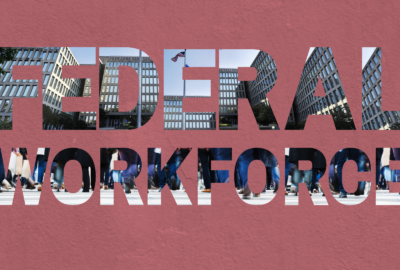
The trouble with online meetings, is online meetings. Or does D.C. really need federal employees to file back to their offices?
Critics of telework often point to its limitations on collaboration. Video meetings have replaced the conference table for millions of teleworkers, but they can be...
Critics of telework often point to its limitations on collaboration. Video meetings have replaced the conference table for millions of teleworkers, but they can be annoying. Earlier, Tom Temin spoke with the D.C. deputy mayor, who outlined why the city wants federal employees to come back or have the government let go of some of its real estate. In this interview, the Federal Drive with Tom Temin turns to Frameable CEO Adam Riggs, who offers another angle on the virtues of virtual meetings.
Interview transcript:
Tom Temin We should point out you have a little bit of federal experience in your background. You were an innovation fellow at the Treasury Department, correct?
Adam Riggs That’s right. I worked at the Treasury Department for one year, and then I moved over to the State Department for two years.
Tom Temin All right. Well, before we get into this, just briefly, what is Frameable and how does it relate to this whole virtual meeting and space issue?
Adam Riggs Sure. So Frameable is a company that’s committed to bringing all of the serendipity and efficiency and pleasure of in-person work, to the distributed work experience. We define distributed work as being both work from home, but also, really it’s any time colleagues are not physically with the people that they are communicating with or collaborating with. So two employees of the same company who are at different locations, we can say that they’re working in a distributed way, because they’re working hard to collaborate with people that they’re not physically with. And work from home is a version of that where the locations not controlled by the company, but the work is still unfolding there.
Tom Temin Sure. Now the popular platforms, teams and so forth, have proven really invaluable, especially when people were forced to be remote, because of the pandemic. And now that’s kind of set in. So what has to be the next, I guess, piece of technology to enhance these types of platforms such that collaboration is improved and the user experience is improved with better sound maybe, better video? You know how some of these things sound. It’s extremely fatiguing after a very short time.
Adam Riggs Absolutely. I think you use the magic words, user experience. There was a time, and it was a long time ago, when live video boxes next to one another was a remarkable technical feat, and it was worth talking about on its own. But those days are long behind us. And now, what we really need is for the providers, that large organizations rely on, to really turn back to the user experience and to the evolution of what it means for someone to use this technology, not just a few times a week when someone’s on the road traveling for work and they need to phone in or video into a to a meeting, but really, every day. These products have not evolved enough in the last ten years, certainly not in the last five years. They definitely have proved invaluable for getting us through the pandemic challenges, and we’re all better off because they were in place. And for the most part, they held up well. But now that people have a different experience and a different expectation about the role of distributed work in their lives, and now that talent acquisition and talent retention really depends on flexibility, these products are going to have to evolve at a much faster rate.
Tom Temin Because there are large screen situations and conference rooms where the cameras can follow you around and really good audio and audio fencing and so forth. Lots of technologies are coming in, but it hasn’t led to somehow the sense that, gosh, the virtual workspace is great. Should it be where everybody is visible all the time and you just talk to someone as if they were sitting out there, but they’re actually not sitting out there. But you can see them all the time. Is that what we’re talking about?
Adam Riggs I don’t think so. I think, it’s a slippery slope to embrace the technology for its own sake. And what I mean by that is, it’s very expensive to put screens up all over a conference room and have high definition cameras, less expensive now than it was ten years ago. But it’s still an expensive proposition, it takes time, it takes requisitions, it takes procurement. And unfortunately, if you take a further step toward virtual reality headsets and things like that, it just doesn’t really make sense. The problem to solve is, the question is, how can we make it so people who are not physically together can collaborate in a natural way? A natural way means a full spectrum of scheduled to unscheduled interactions. Now, that does not mean you always need to be visible. It does not mean you always need to be on camera. It does not necessarily mean anything. It’s a problem statement. And what the providers of the technology need to do is focus on the problem statement and not on a specific solution. Like headsets or fully connected conference rooms that cost a ton of money to install and take years to install before they’re operational. Focus on the problem statement of helping people collaborate in a natural way, even when they are not physically together. And that is what should drive the evolution of these products.
Tom Temin We’re speaking with Adam Riggs. He is CEO of Frameable and a one-time presidential innovation fellow. It sounds almost like a push to talk situation.
Adam Riggs That’s an interesting technology. That is something that those of us who are old enough to remember the first versions of cell phones, we got to play with that a little bit. I think there is something attractive about the on demand nature of that. But there’s a cultural piece there, too. Sure. When you’re in a physical office, you have an expectation or at least an awareness that people might approach you, in an unscheduled moment, to ask for your help or ask you to look at a piece of copy or a piece of a document, a design or something that was not on your calendar. When you’re in a physical office with a bunch of other people, that is something that you know could happen at any time. It could be a colleague, it could be someone who works for you, or it could be your boss. So one of the most interesting things that’s happened, in the last couple of years, is that people have evolved a very different sense of privacy and an expectation of privacy working remotely. If they are in their home, this is a private space. And so the idea of being interrupted by a work colleague in your home is a bit disorienting. You are working, it is work hours, and I am here at my desk doing work. But the idea that a work colleague could interrupt you during work hours, but in your home, is a bit of a mix. It’s hard to process. So I think that, push-to-talk technology and things that make those kinds of interruptions a little bit easier, mechanically. They need to be coupled with a deliberate discussion about the expectation that, hey, we’re on a team, we’re here doing this work together, because it’s not something we can do alone. And when we’re physically together, we are committed to helping one another. And within reason, we are available to our colleagues to help them. And some part of that leaning into collaboration and being helpful to colleagues, I think, does have to move into the approach to work from home that people have. If they insist on all of their interactions being scheduled and on their calendar, it’s going to continue to feel disconnected. And that’s the thing people really have a hard time with remote work.
Tom Temin Because there are non-video options like Slack, which has gotten really popular. And I think Microsoft ended up owning that too, didn’t they? And you can make video calls with Slack. They’re not high grade, but you can also just text someone. So is that what you have in mind or is there some bigger picture? I have the sense you know what this looks like.
Adam Riggs Well, we have a version, which is different from Slack. Slack was purchased by Salesforce, not Microsoft recently. Slack, it started off as a text chat client. There have been many, many generations of text chat clients in the last 20, 30 years. So it’s not new. The video capability is new, because they realized that people get tired of typing. Slack or any kind of chat system is very useful for supporting asynchronous communication between people who are not actually available at the same moment. It’s very efficient, just like email. But at a certain point in that communication, a live interaction becomes the the natural next step. So we think that text chat, video interactions that are live, your scheduled calendar and email all have to come together as kind of the four corners of digital communication infrastructure, in a natural way. Part of the problem is that, if you are a company that relies on different providers for these four cornerstones, you’re going to have a hard time presenting an integrated experience to your employees. I’m not saying everything should always come from the same vendor. I’m just saying that, whether it comes from the same vendor or not, the focus should be on the integrated experience for the employee. Because the integrated experience that they have for themselves, is what’s going to begin to translate into natural interaction with their colleagues, if that makes sense.
Tom Temin Sure. And if you can get all of this together to get to our theme here, then is it possible that the federal government, as a large entity, a large presence in, say, the District of Columbia or other cities, too. But I think as a percentage, it’s the most in D.C., maybe Baltimore, also. That they could just go ahead and proceed with permanent telework at the level that it is, and greater choice. And it will seem more effective as a way to work.
Adam Riggs Well, yes. I think there are many ways to improve the toolkit, that exists right now. And I think that doing so, will help the C-suite in the private sector and the decision makers in the public sector, understand that it’s a false choice. The choice of, either come back together in person or produce inferior work. This is not the choice. There is a way to produce excellent work at high velocity and keep the esprit de corps up and the excitement up and the innovation up. But you have to look at the tools that you’re providing your team and your workforce. And you have to be realistic about what’s possible. So if the decision makers are not willing or able to take a fresh look at the tooling, then it’s possible, and especially if they have a huge real estate commitment, that the most logical thing that they can do is just insist that everybody come back to the real estate footprint that they’ve invested in. But if there is a commitment to rightsizing the real estate footprint, if there’s a commitment to finding talent where it is and being flexible about people’s balance, the balance of time that they have. The work from home statistics are pretty striking. At the moment, it’s a little more than an hour a day. Something like 70 minutes a day on average is saved, on a day where someone works from home versus when they work, including their commute. What they do with that time is pretty remarkable. About half that time, the time saved, about half that time goes to more work. And about the other half of that time goes to a mix of personal health, family obligations, cooking, wellness, etc. So it can truly be a win-win for both the employer and the employee, if the hybrid schedule is enforced in the right way, if people, when they come in to work, are coming in on the same day as the colleagues they need to connect with. And if the tooling, that they are able to use when they’re working from home, is up to the task.
Copyright © 2024 Federal News Network. All rights reserved. This website is not intended for users located within the European Economic Area.
Tom Temin is host of the Federal Drive and has been providing insight on federal technology and management issues for more than 30 years.
Follow @tteminWFED





